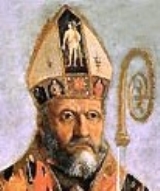
Mitre
Encyclopedia
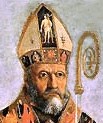
Bishop
A bishop is an ordained or consecrated member of the Christian clergy who is generally entrusted with a position of authority and oversight. Within the Catholic Church, Eastern Orthodox, Oriental Orthodox Churches, in the Assyrian Church of the East, in the Independent Catholic Churches, and in the...
s and certain abbot
Abbot
The word abbot, meaning father, is a title given to the head of a monastery in various traditions, including Christianity. The office may also be given as an honorary title to a clergyman who is not actually the head of a monastery...
s in the Roman Catholic Church
Roman Catholic Church
The Catholic Church, also known as the Roman Catholic Church, is the world's largest Christian church, with over a billion members. Led by the Pope, it defines its mission as spreading the gospel of Jesus Christ, administering the sacraments and exercising charity...
, as well as in the Anglican Communion
Anglican Communion
The Anglican Communion is an international association of national and regional Anglican churches in full communion with the Church of England and specifically with its principal primate, the Archbishop of Canterbury...
, some Lutheran
Lutheranism
Lutheranism is a major branch of Western Christianity that identifies with the theology of Martin Luther, a German reformer. Luther's efforts to reform the theology and practice of the church launched the Protestant Reformation...
churches, and also bishops and certain other clergy in the Eastern Orthodox churches, Eastern Catholic Churches and the Oriental Orthodox Churches
Oriental Orthodoxy
Oriental Orthodoxy is the faith of those Eastern Christian Churches that recognize only three ecumenical councils — the First Council of Nicaea, the First Council of Constantinople and the First Council of Ephesus. They rejected the dogmatic definitions of the Council of Chalcedon...
.
Origin
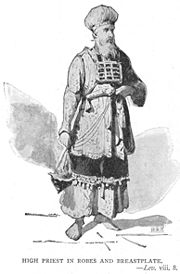
Judaism
In ancient Israel, the Kohen GadolKohen Gadol
The High Priest was the chief religious official of Israelite religion and of classical Judaism from the rise of the Israelite nation until the destruction of the Second Temple of Jerusalem...
(High Priest) wore a headdress called the Mitznefet
Mitznefet
The priestly mitre or turban was the head covering worn by the Jewish High Priest when he served in the Tabernacle and the Temple in Jerusalem.-Etymology:...
(often translated into English
English language
English is a West Germanic language that arose in the Anglo-Saxon kingdoms of England and spread into what was to become south-east Scotland under the influence of the Anglian medieval kingdom of Northumbria...
as "mitre"), which was wound around the head so as to form a broad, flat-topped turban
Turban
In English, Turban refers to several types of headwear popularly worn in the Middle East, North Africa, Punjab, Jamaica and Southwest Asia. A commonly used synonym is Pagri, the Indian word for turban.-Styles:...
. Attached to it was the Tzitz
Tzitz
The priestly crown or frontlet was the golden plate or tiara worn by the Jewish High Priest on his mitre or turban whenever he would minister in the Tabernacle or the Temple in Jerusalem.-Etymology:...
, a plate of solid gold bearing the inscription "Holiness
Sacred
Holiness, or sanctity, is in general the state of being holy or sacred...
to YHWH" .
Byzantine empire
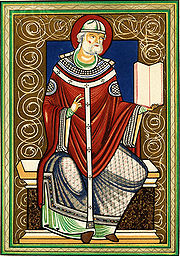
Greek language
Greek is an independent branch of the Indo-European family of languages. Native to the southern Balkans, it has the longest documented history of any Indo-European language, spanning 34 centuries of written records. Its writing system has been the Greek alphabet for the majority of its history;...
: καμιλαύκιον
Kamilavka
A Kalimavkion , or kalymmavchi , or kamilavka , is an item of clerical clothing worn by Orthodox Christian and Eastern Catholic monks or awarded to clergy ....
, kamilaukion), the headdress both the mitre and the Papal tiara
Papal Tiara
The Papal Tiara, also known incorrectly as the Triple Tiara, or in Latin as the Triregnum, in Italian as the Triregno and as the Trirègne in French, is the three-tiered jewelled papal crown, supposedly of Byzantine and Persian origin, that is a prominent symbol of the papacy...
stem from, was originally a cap used by officials of the Imperial Byzantine
Byzantine Empire
The Byzantine Empire was the Eastern Roman Empire during the periods of Late Antiquity and the Middle Ages, centred on the capital of Constantinople. Known simply as the Roman Empire or Romania to its inhabitants and neighbours, the Empire was the direct continuation of the Ancient Roman State...
court. "The tiara [from which the mitre originates] probably developed from the Phrygian cap, or frigium, a conical cap worn in the Graeco-Roman world. In the 10th century the tiara was pictured on papal coins." Other sources claim the tiara developed the other way around, from the mitre. In the late Empire it developed into the closed type of Imperial crown
Crown (headgear)
A crown is the traditional symbolic form of headgear worn by a monarch or by a deity, for whom the crown traditionally represents power, legitimacy, immortality, righteousness, victory, triumph, resurrection, honour and glory of life after death. In art, the crown may be shown being offered to...
used by Byzantine Emperors (see illustration of Michael III
Michael III
Michael III , , Byzantine Emperor from 842 to 867. Michael III was the third and traditionally last member of the Amorian-Phrygian Dynasty...
, 842-867).
In Western Europe, the mitre was first used in ancient Rome by the Salii
Salii
In ancient Roman religion, the Salii were the "leaping priests" of Mars supposed to have been introduced by King Numa Pompilius. They were twelve patrician youths, dressed as archaic warriors: an embroidered tunic, a breastplate, a short red cloak , a sword, and a spiked headdress called an apex...
and other priests, and outside of Rome about the year 1000. Worn by a bishop, the mitre is depicted for the first time in two miniatures of the beginning of the eleventh century. The first written mention of it is found in a Bull
Papal bull
A Papal bull is a particular type of letters patent or charter issued by a Pope of the Catholic Church. It is named after the bulla that was appended to the end in order to authenticate it....
of Pope Leo IX
Pope Leo IX
Pope Saint Leo IX , born Bruno of Eguisheim-Dagsburg, was Pope from February 12, 1049 to his death. He was a German aristocrat and as well as being Pope was a powerful secular ruler of central Italy. He is regarded as a saint by the Roman Catholic Church, with the feast day of April 19...
in the year 1049. By 1150 the use had spread to bishops throughout the West; by the 14th century the tiara was decorated with three crowns.
Christian clergy
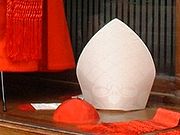
Western Christianity
In its modern form in Western ChristianityWestern Christianity
Western Christianity is a term used to include the Latin Rite of the Catholic Church and groups historically derivative thereof, including the churches of the Anglican and Protestant traditions, which share common attributes that can be traced back to their medieval heritage...
, the mitre is a tall folding cap
Cap
A cap is a form of headgear. Caps have crowns that fit very close to the head and have no brim or only a visor. They are typically designed for warmth and, when including a visor, blocking sunlight from the eyes...
, consisting of two similar parts (the front and back) rising to a peak and sewn together at the sides. Two short lappet
Lappet
A lappet is a decorative flap or fold in a ceremonial headdress or garment. They were a feature of women's headgear until the early 20th century. They remain strongly associated with religion. A bishop's mitre has two lappets sewn to the back of it. The most famous usage of lappets occurs on the...
s always hang down from the back.
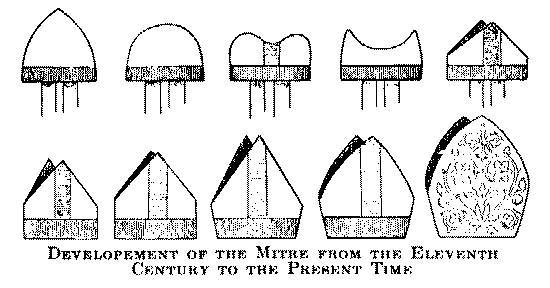
Canon law (Catholic Church)
The canon law of the Catholic Church, is a fully developed legal system, with all the necessary elements: courts, lawyers, judges, a fully articulated legal code and principles of legal interpretation. It lacks the necessary binding force present in most modern day legal systems. The academic...
to bishop
Bishop
A bishop is an ordained or consecrated member of the Christian clergy who is generally entrusted with a position of authority and oversight. Within the Catholic Church, Eastern Orthodox, Oriental Orthodox Churches, in the Assyrian Church of the East, in the Independent Catholic Churches, and in the...
s and to abbot
Abbot
The word abbot, meaning father, is a title given to the head of a monastery in various traditions, including Christianity. The office may also be given as an honorary title to a clergyman who is not actually the head of a monastery...
s, as it appears in the ceremony of consecration
Consecration
Consecration is the solemn dedication to a special purpose or service, usually religious. The word "consecration" literally means "to associate with the sacred". Persons, places, or things can be consecrated, and the term is used in various ways by different groups...
of a bishop and blessing of an abbot. Cardinals
Cardinal (Catholicism)
A cardinal is a senior ecclesiastical official, usually an ordained bishop, and ecclesiastical prince of the Catholic Church. They are collectively known as the College of Cardinals, which as a body elects a new pope. The duties of the cardinals include attending the meetings of the College and...
are now normally supposed to be bishops (since the time of Pope John XXIII
Pope John XXIII
-Papal election:Following the death of Pope Pius XII in 1958, Roncalli was elected Pope, to his great surprise. He had even arrived in the Vatican with a return train ticket to Venice. Many had considered Giovanni Battista Montini, Archbishop of Milan, a possible candidate, but, although archbishop...
), but even cardinals who are not bishops and who have been given special permission by the pope to decline consecration as bishops may wear the mitre. Other prelate
Prelate
A prelate is a high-ranking member of the clergy who is an ordinary or who ranks in precedence with ordinaries. The word derives from the Latin prælatus, the past participle of præferre, which means "carry before", "be set above or over" or "prefer"; hence, a prelate is one set over others.-Related...
s have been granted the use of the mitre by special privilege
Privilege (canon law)
Privilege in the Canon law of the Roman Catholic Church is the legal concept whereby someone is exempt from the ordinary operation of the law over time for some specific purpose.-Definition:...
, but this is no longer done, except in the case of an Ordinary of a Personal Ordinariate (even if he is a priest only). Former distinctions between "mitred abbots" and "non-mitred abbots" have been abolished.
Three types of mitres are worn by Roman Catholic clergy for different occasions:
- The simplex ('simple', referring to the materials used) is made of undecorated white linen or silk and its white lappets traditionally end in red fringes. It is worn most notably at funerals, on Good FridayGood FridayGood Friday , is a religious holiday observed primarily by Christians commemorating the crucifixion of Jesus Christ and his death at Calvary. The holiday is observed during Holy Week as part of the Paschal Triduum on the Friday preceding Easter Sunday, and may coincide with the Jewish observance of...
and by concelebrant bishops at a MassMassMass can be defined as a quantitive measure of the resistance an object has to change in its velocity.In physics, mass commonly refers to any of the following three properties of matter, which have been shown experimentally to be equivalent:...
. Cardinals in the presence of the Pope wear a mitre of white linen damask. - The pretiosa ('precious') is decorated with precious stones and gold and worn on Sundays and feast days. This type of mitre is rarely decorated with precious stones today, and the designs have become more varied, simple and original, often merely being in the liturgical colour of the day.
- The auriphrygiata is of plain gold cloth or white silk with gold, silver or coloured embroidered bands; when seen today it is usually worn by bishops when they preside at the celebration of the sacraments.
The proper colour of a mitre is always white, although in liturgical usage white also includes vestments made from gold and silver fabrics. The embroidered bands and other ornaments which adorn a mitre and the lappets may be of other colours and often are. Although coloured mitres are sometimes sold and worn at present, this is probably due to the maker’s or wearer’s lack of awareness of liturgical tradition.
On all occasions, an altar server
Altar server
An altar server is a lay assistant to a member of the clergy during a Christian religious service. An altar server attends to supporting tasks at the altar such as fetching and carrying, ringing the altar bell and so on....
may wear a shawl-like veil
Veil
A veil is an article of clothing, worn almost exclusively by women, that is intended to cover some part of the head or face.One view is that as a religious item, it is intended to show honor to an object or space...
, called a vimpa
Vimpa
A vimpa is a veil or shawl worn over the shoulders of servers who carry the miter and crosier during liturgical functions when they are not being used by the bishop, in the Roman Catholic, Anglican, and some other western churches....
, around the shoulders when holding the bishop's mitre. The vimpa is used to hold the mitre so as to avoid the possibility of it being soiled by the natural oils in a person's hand as well as symbolically showing that the person does not own the mitre, but merely holds it for the prelate.
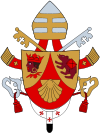
Papal Inauguration
The Papal Inauguration is a liturgical service of the Catholic Church within Mass celebrated in the Roman Rite but with elements of Byzantine Rite for the ecclesiastical investiture of the Pope...
, Benedict XVI
Pope Benedict XVI
Benedict XVI is the 265th and current Pope, by virtue of his office of Bishop of Rome, the Sovereign of the Vatican City State and the leader of the Catholic Church as well as the other 22 sui iuris Eastern Catholic Churches in full communion with the Holy See...
broke with tradition and replaced the papal tiara
Papal Tiara
The Papal Tiara, also known incorrectly as the Triple Tiara, or in Latin as the Triregnum, in Italian as the Triregno and as the Trirègne in French, is the three-tiered jewelled papal crown, supposedly of Byzantine and Persian origin, that is a prominent symbol of the papacy...
even on his papal coat of arms
Coat of arms of Pope Benedict XVI
The coat of arms of Pope Benedict XVI was designed by then Archbishop Andrea Cordero Lanza di Montezemolo soon after the papal election. The coat of arms consists of a shield and external ornaments.-Shield:...
with a papal mitre (containing still the three levels of 'crowns' representing the powers of the Papacy in a simplified form) and pallium
Pallium
The pallium is an ecclesiastical vestment in the Roman Catholic Church, originally peculiar to the Pope, but for many centuries bestowed by him on metropolitans and primates as a symbol of the jurisdiction delegated to them by the Holy See. In that context it has always remained unambiguously...
. Prior to Benedict XVI, each pope's coat of arms always contained the image of the papal tiara and St. Peter's crossed keys, even though the tiara had fallen into disuse, especially under popes John Paul I
Pope John Paul I
John Paul I , born Albino Luciani, , reigned as Pope of the Catholic Church and as Sovereign of Vatican City from 26 August 1978 until his death 33 days later. His reign is among the shortest in papal history, resulting in the most recent Year of Three Popes...
and John Paul II
Pope John Paul II
Blessed Pope John Paul II , born Karol Józef Wojtyła , reigned as Pope of the Catholic Church and Sovereign of Vatican City from 16 October 1978 until his death on 2 April 2005, at of age. His was the second-longest documented pontificate, which lasted ; only Pope Pius IX ...
. Pope Paul VI
Pope Paul VI
Paul VI , born Giovanni Battista Enrico Antonio Maria Montini , reigned as Pope of the Catholic Church from 21 June 1963 until his death on 6 August 1978. Succeeding Pope John XXIII, who had convened the Second Vatican Council, he decided to continue it...
was the last pope to date to begin his papal reign with a formal coronation in June 1963. However, as a sign of the need for greater simplification of the papal rites, as well as the changing nature of the papacy itself, he abandoned the use of his tiara in a dramatic ceremony in Saint Peter's Basilica during the second session of Vatican II
Second Vatican Council
The Second Vatican Council addressed relations between the Roman Catholic Church and the modern world. It was the twenty-first Ecumenical Council of the Catholic Church and the second to be held at St. Peter's Basilica in the Vatican. It opened under Pope John XXIII on 11 October 1962 and closed...
in November 1963. However his 1975 Apostolic Constitution
Apostolic constitution
An apostolic constitution is the highest level of decree issued by the Pope. The use of the term constitution comes from Latin constitutio, which referred to any important law issued by the Roman emperor, and is retained in church documents because of the inheritance that the canon law of the...
made it clear the tiara had not been abolished: in the constitution he made provision for his successor to receive a coronation. Pope John Paul I, however, declined to follow Paul VI's constitution and opted for a simpler papal inauguration
Papal Inauguration
The Papal Inauguration is a liturgical service of the Catholic Church within Mass celebrated in the Roman Rite but with elements of Byzantine Rite for the ecclesiastical investiture of the Pope...
, a precedent followed by his two successors. Pope John Paul II's 1996 Apostolic Constitution left open several options by not specifying what sort of ceremony was to be used, other than that some ceremony would be held to inaugurate a new pontificate.
Pope Paul VI donated his tiara (a gift from his former archdiocese of Milan) to the efforts at relieving poverty in the world. Later, Francis Cardinal Spellman of New York received the tiara and took it on tour of the United States to raise funds for the poor. It is on permanent view in the Crypt Church in the Basilica of the National Shrine of the Immaculate Conception
Basilica of the National Shrine of the Immaculate Conception
The Basilica of the National Shrine of the Immaculate Conception is a prominent Latin Rite Catholic basilica located in Washington, D.C., honoring the Blessed Virgin Mary as Our Lady of the Immaculate Conception, the Patroness of the United States...
in Washington, D.C.
Washington, D.C.
Washington, D.C., formally the District of Columbia and commonly referred to as Washington, "the District", or simply D.C., is the capital of the United States. On July 16, 1790, the United States Congress approved the creation of a permanent national capital as permitted by the U.S. Constitution....
In the Church of England
Church of England
The Church of England is the officially established Christian church in England and the Mother Church of the worldwide Anglican Communion. The church considers itself within the tradition of Western Christianity and dates its formal establishment principally to the mission to England by St...
the mitre fell out of use after the Reformation, but was restored in the late 19th and early 20th centuries as a result of the Oxford Movement
Oxford Movement
The Oxford Movement was a movement of High Church Anglicans, eventually developing into Anglo-Catholicism. The movement, whose members were often associated with the University of Oxford, argued for the reinstatement of lost Christian traditions of faith and their inclusion into Anglican liturgy...
, and is now worn by most bishops of the Anglican Communion
Anglican Communion
The Anglican Communion is an international association of national and regional Anglican churches in full communion with the Church of England and specifically with its principal primate, the Archbishop of Canterbury...
on at least some occasions.
The mitre has always been used in ecclesiastical heraldry
Ecclesiastical heraldry
Ecclesiastical heraldry is the tradition of heraldry developed by Christian clergy. Initially used to mark documents, ecclesiastical heraldry evolved as a system for identifying people and dioceses. It is most formalized within the Catholic Church, where most bishops, including the Pope, have a...
to surmount the coats of arms of bishops in the Church of England (instead of a crest
Crest (heraldry)
A crest is a component of an heraldic display, so called because it stands on top of a helmet, as the crest of a jay stands on the bird's head....
, which is not used by clergy). In 1969 the mitre was suppressed in all personal arms of bishops in the Catholic Church, and is since only found on diocesan coats of arms. In heraldry the lappets are depicted with red lining.
Eastern Christianity
The most typical mitre in the Eastern Orthodox and Byzantine CatholicEastern Rite Catholic Churches
The Eastern Catholic Churches are autonomous, self-governing particular churches in full communion with the Bishop of Rome, the Pope. Together with the Latin Church, they compose the worldwide Catholic Church...
churches is based on the closed Imperial crown of the late Byzantine Empire
Byzantine Empire
The Byzantine Empire was the Eastern Roman Empire during the periods of Late Antiquity and the Middle Ages, centred on the capital of Constantinople. Known simply as the Roman Empire or Romania to its inhabitants and neighbours, the Empire was the direct continuation of the Ancient Roman State...
. Therefore, it too is ultimately based on the older καμιλαύκιον although it diverged from the secular headdress at a much later date, after it had already undergone further development. The crown form was not used by bishops until after the fall of Constantinople
Fall of Constantinople
The Fall of Constantinople was the capture of the capital of the Byzantine Empire, which occurred after a siege by the Ottoman Empire, under the command of Ottoman Sultan Mehmed II, against the defending army commanded by Byzantine Emperor Constantine XI...
(1453).
The Eastern mitre is made in the shape of a bulbous crown, completely enclosed, and the material is of brocade
Brocade
Brocade is a class of richly decorative shuttle-woven fabrics, often made in colored silks and with or without gold and silver threads. The name, related to the same root as the word "broccoli," comes from Italian broccato meaning "embossed cloth," originally past participle of the verb broccare...
, damask
Damask
Damask is a reversible figured fabric of silk, wool, linen, cotton, or synthetic fibers, with a pattern formed by weaving. Damasks are woven with one warp yarn and one weft yarn, usually with the pattern in warp-faced satin weave and the ground in weft-faced or sateen weave...
or cloth of gold
Cloth of gold
Cloth of gold is a fabric woven with a gold-wrapped or spun weft - referred to as "a spirally spun gold strip". In most cases, the core yarn is silk wrapped with a band or strip of high content gold filé...
. It may also be embroidered
Embroidery
Embroidery is the art or handicraft of decorating fabric or other materials with needle and thread or yarn. Embroidery may also incorporate other materials such as metal strips, pearls, beads, quills, and sequins....
, and is often richly decorated with jewels. There are normally four icons attached to the mitre (often of Christ, the Theotokos
Theotokos
Theotokos is the Greek title of Mary, the mother of Jesus used especially in the Eastern Orthodox, Oriental Orthodox, and Eastern Catholic Churches. Its literal English translations include God-bearer and the one who gives birth to God. Less literal translations include Mother of God...
, John the Baptist
John the Baptist
John the Baptist was an itinerant preacher and a major religious figure mentioned in the Canonical gospels. He is described in the Gospel of Luke as a relative of Jesus, who led a movement of baptism at the Jordan River...
and the Cross
Christian cross
The Christian cross, seen as a representation of the instrument of the crucifixion of Jesus Christ, is the best-known religious symbol of Christianity...
), which the bishop may kiss before he puts it on. Eastern mitres are usually gold, but other liturgical colours
Liturgical colours
Liturgical colours are those specific colours which are used for vestments and hangings within the context of Christian liturgy. The symbolism of violet, white, green, red, gold, black, rose, and other colours may serve to underline moods appropriate to a season of the liturgical year or may...
may be used.
The mitre is topped by a cross, either made out of metal and standing upright, or embroidered in cloth and lying flat on the top. In Greek practice
Greek Orthodox Church
The Greek Orthodox Church is the body of several churches within the larger communion of Eastern Orthodox Christianity sharing a common cultural tradition whose liturgy is also traditionally conducted in Koine Greek, the original language of the New Testament...
, the mitres of all bishops are topped with a standing cross. The same is true in the Russian tradition
Russian Orthodox Church
The Russian Orthodox Church or, alternatively, the Moscow Patriarchate The ROC is often said to be the largest of the Eastern Orthodox churches in the world; including all the autocephalous churches under its umbrella, its adherents number over 150 million worldwide—about half of the 300 million...
. Mitres awarded to priests will have the cross lying flat. Sometimes, instead of the flat cross, the mitre may have an icon
Icon
An icon is a religious work of art, most commonly a painting, from Eastern Christianity and in certain Eastern Catholic churches...
on the top.
As an item of Imperial regalia, along with other such items as the sakkos
Sakkos
The Sakkos is a vestment worn by Orthodox and Greek Catholic bishops instead of the priest's phelonion. The garment is a tunic with wide sleeves, and a distinctive pattern of trim. It reaches below the knees and is fastened up the sides with buttons or tied with ribbons...
(Imperial dalmatic
Dalmatic
The dalmatic is a long wide-sleeved tunic, which serves as a liturgical vestment in the Roman Catholic, Lutheran, Anglican, and United Methodist Churches, which is sometimes worn by a deacon at the Mass or other services. Although infrequent, it may also be worn by bishops above the alb and below...
) and epigonation
Epigonation
The epigonation , or palitza , is a vestment used in some Eastern Christian churches.-Description and usage:...
, the mitre came to signify the temporal authority of bishops (especially that of the Patriarch of Constantinople
Patriarch of Constantinople
The Ecumenical Patriarch is the Archbishop of Constantinople – New Rome – ranking as primus inter pares in the Eastern Orthodox communion, which is seen by followers as the One, Holy, Catholic, and Apostolic Church....
) within the administration of the Rum millet
Millet (Ottoman Empire)
Millet is a term for the confessional communities in the Ottoman Empire. It refers to the separate legal courts pertaining to "personal law" under which communities were allowed to rule themselves under their own system...
(i.e., the Christian community) of the Ottoman Empire
Ottoman Empire
The Ottoman EmpireIt was usually referred to as the "Ottoman Empire", the "Turkish Empire", the "Ottoman Caliphate" or more commonly "Turkey" by its contemporaries...
. The mitre is removed at certain solemn moments during the Divine Liturgy
Divine Liturgy
Divine Liturgy is the common term for the Eucharistic service of the Byzantine tradition of Christian liturgy. As such, it is used in the Eastern Orthodox and Eastern Catholic Churches. Armenian Christians, both of the Armenian Apostolic Church and of the Armenian Catholic Church, use the same term...
and other services, usually being removed and replaced by the protodeacon
Protodeacon
Protodeacon derives from the Greek proto- meaning 'first' and diakonos, which is a standard ancient Greek word meaning "servant", "waiting-man," "minister" or "messenger." The word in English may refer to various clergymen, depending upon the usage of the particular church in question.-Eastern...
.
The use of the mitre is a prerogative of bishops, but it may be awarded to archpriest
Archpriest
An archpriest is a priest with supervisory duties over a number of parishes. The term is most often used in Eastern Orthodoxy and Eastern Catholic Churches, although it may be used in the Latin rite of the Roman Catholic Church instead of dean or vicar forane.In the 16th and 17th centuries, during...
s, protopresbyters and archimandrite
Archimandrite
The title Archimandrite , primarily used in the Eastern Orthodox and the Eastern Catholic churches, originally referred to a superior abbot whom a bishop appointed to supervise...
s. The priestly mitre is not surmounted by a cross, and is awarded at the discretion of a synod
Synod
A synod historically is a council of a church, usually convened to decide an issue of doctrine, administration or application. In modern usage, the word often refers to the governing body of a particular church, whether its members are meeting or not...
of bishops.
Oriental Orthodox Christianity
Oriental Orthodox bishops sometimes use mitres, either of the Western or Eastern style. In the past, CopticCoptic Christianity
The Coptic Orthodox Church of Alexandria is the official name for the largest Christian church in Egypt and the Middle East. The Church belongs to the Oriental Orthodox family of churches, which has been a distinct church body since the Council of Chalcedon in AD 451, when it took a different...
bishops have worn the ballin, an omophorion
Omophorion
In the Eastern Orthodox and Eastern Catholic liturgical tradition, the omophor is the distinguishing vestment of a bishop and the symbol of his spiritual and ecclesiastical authority...
wound around the head like a turban
Turban
In English, Turban refers to several types of headwear popularly worn in the Middle East, North Africa, Punjab, Jamaica and Southwest Asia. A commonly used synonym is Pagri, the Indian word for turban.-Styles:...
. The Coptic Patriarch of Alexandria will often wear an Eastern-style mitre. Coptic priests frequently wear a mitre, similar to a Western bishop's mitre.
Syriac Orthodox
Syriac Orthodox Church
The Syriac Orthodox Church; is an autocephalous Oriental Orthodox church based in the Eastern Mediterranean, with members spread throughout the world. The Syriac Orthodox Church claims to derive its origin from one of the first Christian communities, established in Antioch by the Apostle St....
bishops wear the maşnaphto (literally, 'turban') when presiding at the Divine Liturgy
Divine Liturgy
Divine Liturgy is the common term for the Eucharistic service of the Byzantine tradition of Christian liturgy. As such, it is used in the Eastern Orthodox and Eastern Catholic Churches. Armenian Christians, both of the Armenian Apostolic Church and of the Armenian Catholic Church, use the same term...
. This is a large, richly embroidered hood, often depicting the Holy Spirit
Holy Spirit
Holy Spirit is a term introduced in English translations of the Hebrew Bible, but understood differently in the main Abrahamic religions.While the general concept of a "Spirit" that permeates the cosmos has been used in various religions Holy Spirit is a term introduced in English translations of...
as a dove.
Armenian Apostolic bishops wear tall and distinctively tapered Western-style mitres. The Armenian bishop's mitre differs from its Western counterpart in that the points at the top are usually joined together. Armenian priests regularly wear Byzantine-style mitres (symbolizing the sovereignty of Christ). On certain solemn occasions, Armenian deacons will wear the mitre also, although the deacon's mitre is somewhat narrower than that of the priest.
Grenadiers
During the 18th Century (an in some few cases the 19th), soldiers serving as grenadiersGrenadier (soldier)
A grenadier was originally a specialized soldier, first established as a distinct role in the mid-to-late 17th century, for the throwing of grenades and sometimes assault operations. At this time grenadiers were chosen from the strongest and largest soldiers...
in various northern European armies wore a mitre similar to those worn by Western bishops, but made out of metal rather than fabric. The mitre survived as parade dress in a few Prussia
Prussia
Prussia was a German kingdom and historic state originating out of the Duchy of Prussia and the Margraviate of Brandenburg. For centuries, the House of Hohenzollern ruled Prussia, successfully expanding its size by way of an unusually well-organized and effective army. Prussia shaped the history...
n and Russia
Russia
Russia or , officially known as both Russia and the Russian Federation , is a country in northern Eurasia. It is a federal semi-presidential republic, comprising 83 federal subjects...
n grenadier regiments until World War I
World War I
World War I , which was predominantly called the World War or the Great War from its occurrence until 1939, and the First World War or World War I thereafter, was a major war centred in Europe that began on 28 July 1914 and lasted until 11 November 1918...
. Militarily, they would come in different styles. The "German" style being a cone shaped structure completely embroidered with cloth, the "Russian" style consisting of a tall brass plate atop of a leather cap with a peak at the rear and the "British" style being a tall cloth front-plate forward of a smaller red cap, lined in white. Towards the end of the 18th century in most armies, bar the Russian, the mitre gave way to the bearskin
Bearskin
A bearskin is a tall fur cap, usually worn as part of a ceremonial military uniform. Traditionally, the bearskin was the headgear of grenadiers, and is still worn by grenadier and guards regiments in various armies.-Origins:...
. Some fusilier
Fusilier
Fusilier was originally the name of a soldier armed with a light flintlock musket called the fusil. The word was first used around 1680, and has later developed into a regimental designation.-History:...
regiments also donned a mitre with a smaller brass front-plate.
Other uses
The bishopBishop (chess)
A bishop is a piece in the board game of chess. Each player begins the game with two bishops. One starts between the king's knight and the king, the other between the queen's knight and the queen...
in the board game chess
Chess
Chess is a two-player board game played on a chessboard, a square-checkered board with 64 squares arranged in an eight-by-eight grid. It is one of the world's most popular games, played by millions of people worldwide at home, in clubs, online, by correspondence, and in tournaments.Each player...
is represented by a stylized Western mitre.
The crown
Crown (headgear)
A crown is the traditional symbolic form of headgear worn by a monarch or by a deity, for whom the crown traditionally represents power, legitimacy, immortality, righteousness, victory, triumph, resurrection, honour and glory of life after death. In art, the crown may be shown being offered to...
s of the Austrian Empire
Austrian Empire
The Austrian Empire was a modern era successor empire, which was centered on what is today's Austria and which officially lasted from 1804 to 1867. It was followed by the Empire of Austria-Hungary, whose proclamation was a diplomatic move that elevated Hungary's status within the Austrian Empire...
and Imperial Russia incorporated a mitre of precious metal and jewels into their design. The Austrian imperial crown was originally the personal crown of the Holy Roman Emperor Matthias II
Matthias, Holy Roman Emperor
Matthias of Austria was Holy Roman Emperor from 1612, King of Hungary and Croatia from 1608 and King of Bohemia from 1611...
(1612–19) and has the form proper to that of a Holy Roman Emperor. At their coronations as Roman Emperors in Rome the pope placed a mitre on their heads before placing the crown over it. Their empress consorts also received both a mitre and crown on their heads from a cardinal bishop at the same ceremony. The form of the Russian imperial crown dates back to the time of Peter the Great’s early attempts to westernize Russian and was probably inspired by the crowns worn by Habsburg emperors of the Holy Roman Empire but also from orthodox mitre.
Abbesses of certain very ancient abbeys in the West also wore mitres, but of a very different form than that worn by male prelates. These mitres probably had their origins in the caps worn by deaconesses in the early church, since at the time these abbeys the order of deaconesses still existed in the West and the abbess foundresses of these monasteries were deaconesses.
The mitral valve of the human heart, which is located between the left atrium and the left ventricle, is named so because of its similarity in shape to the mitre. Andreas Vesalius, the father of anatomy, noted the striking similarity between the two while performing anatomic dissections in the sixteenth century.
External links
- "Mitre" article from the Classic Encyclopedia
- Mitres Photographs and descriptions of the different types of mitres
- Episcopal Mitre from Kavsokalyvia, Mount AthosMount AthosMount Athos is a mountain and peninsula in Macedonia, Greece. A World Heritage Site, it is home to 20 Eastern Orthodox monasteries and forms a self-governed monastic state within the sovereignty of the Hellenic Republic. Spiritually, Mount Athos comes under the direct jurisdiction of the...
- Information, pictures and literature about clerical headgear in German language
- http://www.magyarkepek.hu/szelenyi/zoom-u03.html Mitre worn by the Archbishop of Esztergom, the Primate of Hungary, at coronations of Kings of Hungary.
- http://photography.nationalgeographic.com/photography/enlarge/jeweled-miter_pod_image.html Mitre worn by Pope John Paul I at his papal inauguration Mass. From the National Geographic book Inside the Vatican, 1991.

